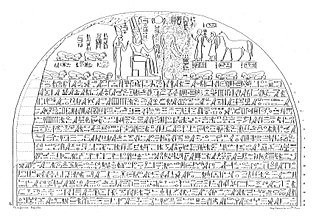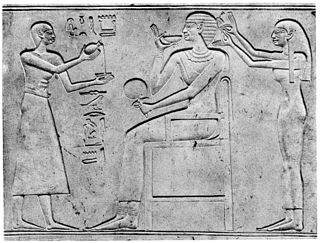
Piye was an ancient Kushite king and founder of the Twenty-fifth Dynasty of Egypt, who ruled Egypt from 744–714 BC. He ruled from the city of Napata, located deep in Nubia, modern-day Sudan.

Hetepheres II was a queen of ancient Egypt during the 4th Dynasty.

Amenirdis I was a God's Wife of Amun during the 25th Dynasty of ancient Egypt. Originating from the Kingdom of Kush, she was the daughter of Pharaoh Kashta and Queen Pebatjma, and was later adopted by Shepenupet I. She went on to rule as high priestess, and has been shown in several artifacts from the period.

Great Royal Wife, or alternatively, Chief King's Wife is the title that was used to refer to the principal wife of the pharaoh of Ancient Egypt, who served many official functions.
Khamerernebty II was an ancient Egyptian queen of the 4th Dynasty. She was a daughter of Pharaoh Khafre and Queen Khamerernebty I. She married her brother Menkaure and she was the mother of Prince Khuenre.

Neferhetepes was an ancient Egyptian princess of the 4th Dynasty; a daughter of Pharaoh Djedefre who ruled between his father Khufu and his brother Khafre. Her mother was Hetepheres II.
Meretnebty was a queen consort of Egypt as a wife of Pharaoh Sahure. She lived during the 5th Dynasty and was named after Two Ladies, a pair of Egyptian goddesses who protected the pharaoh.
Khensa (Khenensaiuw) was a Nubian queen dated to the Twenty-fifth Dynasty of Egypt.
Peksater (Pekerslo) was a Nubian queen dated to the Twenty-fifth Dynasty of Egypt.
Qalhata was a Nubian queen dated to the Twenty-fifth Dynasty of Egypt.
Nikaure was an ancient Egyptian prince and vizier during the 4th Dynasty. His titles include king's eldest son of his body, as well as chief justice and vizier.

The Eighteenth Dynasty of Egypt is classified as the first dynasty of the New Kingdom of Egypt, the era in which ancient Egypt achieved the peak of its power. The Eighteenth Dynasty spanned the period from 1550/1549 to 1292 BC. This dynasty is also known as the Thutmoside Dynasty) for the four pharaohs named Thutmose.

Bunefer was an ancient Egyptian queen from the 4th or 5th dynasty. It is not known which king she was married to. Bunefer was buried in tomb G 8408 in the Central Field of the Giza Necropolis.

Pebatjma was a Nubian queen dated to the Twenty-fifth Dynasty of Egypt. She was the wife of King Kashta. She is mentioned on a statue of her daughter Amenirdis I, now in Cairo (42198). She is also mentioned on a doorjamb from Abydos.

Iah was a king's mother and queen of ancient Egypt c. 2060 BC, during the mid 11th Dynasty. Daughter of a pharaoh, possibly Intef II, and mother of pharaoh Mentuhotep II, she was the queen of Intef III.

Ashayet or Ashait was an ancient Egyptian queen consort, a wife of Mentuhotep II in the 11th Dynasty. Her tomb (DBXI.17) and small decorated chapel were found in Mentuhotep II's Deir el-Bahari temple complex. The shrine and burial to Ashayet was found along with the tombs of four other women in their twenties and a young girl, Henhenet, Kawit, Kemsit, Sadeh and Mayet. However, it is likely that there were three other additional shrines that were destroyed in the expansions of Mentuhotep II's burial complex. The nine shrines were built in the First Intermediate Period, prior to Mentuhotep II's reunification of Egypt. She and three other women of the six bore queenly titles, and most of them were Priestesses of Hathor. The location of their burial is significant to their titles as Priestesses of Hathor as the cliffs of Deir el-Bahri were sacred to Hathor from the Old Kingdom onwards.

Henhenet was an ancient Egyptian queen consort, a lower ranking wife of Pharaoh Mentuhotep II of the 11th dynasty. Her tomb (DBXI.11) and small decorated chapel were found in her husband's Deir el-Bahari temple complex, behind the main building, along with the tombs of five other ladies, Ashayet, Kawit, Kemsit, Sadeh and Mayet. Most of them were priestesses of Hathor, so it is possible that they were buried there as part of the goddess's cult, but it is also possible that they were the daughters of nobles the king wanted to keep an eye upon.

Kawit was an ancient Egyptian queen consort, a lower ranking wife of Pharaoh Mentuhotep II of the 11th Dynasty. Her tomb (DBXI.9) and small decorated chapel were found in her husband's Deir el-Bahari temple complex, behind the main building, along with the tombs of five other ladies, Ashayet, Henhenet, Kemsit, Sadeh and Mayet. She and three other women of the six bore queenly titles, and most of them were priestesses of Hathor, so it is possible that they were buried there as part of the goddess's cult, but it is also possible that they were the daughters of nobles the king wanted to keep an eye upon.

Kemsit was an ancient Egyptian queen consort, the wife of pharaoh Mentuhotep II of the 11th Dynasty. Her tomb (TT308) and small decorated chapel were found in her husband's Deir el-Bahari temple complex, behind the main building, along with the tombs of five other ladies, Ashayet, Henhenet, Kawit, Sadeh and Mayet. Most of them were priestesses of Hathor, so it is possible that they were buried there as part of the goddess's cult, but it is also possible that they were the daughters of nobles the king wanted to keep an eye upon.

Sadeh or Sadhe was an ancient Egyptian queen consort, a lower ranking wife of Pharaoh Mentuhotep II of the 11th Dynasty. Her tomb (DBXI.7) and small decorated chapel were found in her husband's Deir el-Bahari temple complex, behind the main building, along with the tombs of five other women, Ashayet, Henhenet, Kawit, Kemsit and Mayet. She and three other women of the six bore queenly titles, and most of them were priestesses of Hathor, so it is possible that they were buried there as part of the goddess's cult, but it is also possible that they were the daughters of nobles the king wanted to keep an eye upon.













